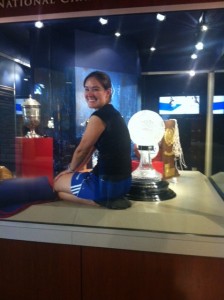by Anne T. Lane

Choosing of candidates from among available objects is first a matter of research – into the database, into the holdings of potential lenders. A list of possibilities is given to collections staff who bring them out for the curator and exhibition designer to see. Each item is evaluated not only for suitability in telling the story, but for its condition and its vulnerability to the stresses of handling and light exposure. Sometimes mere size or weight are limiting factors, or whether or not the item can be protected from curious visitors who don’t recognize the damage their handling can cause.
Once choices are made, a series of steps is followed in order to prepare the items for exhibition. Condition reports are updated or written, and images made to support them. The exhibition designers must know sizes and lighting requirements in order to determine casework and placement, as well as the possible need for rotation of vulnerable items. Collections staff in turn must determine what mounts or supports to construct to ensure stability of each object. Both exhibition designers and collections staff must have a thorough knowledge of acceptable materials for a safe exhibition environment. This includes not only casework, mounts, and coatings, but also graphics substrates and inks, and adhesives.

Even after an exhibition is buttoned up, exhibits and collections staff must check regularly that vitrines are clean, that nothing has been jarred out of place, that visitors haven’t found ways to handle or disturb the objects, and that light levels are properly maintained. Collections staff also inspect for evidence of pests. If anything is found to be awry, it is reported to the appropriate department and remedied with as little disturbance to the exhibition as possible.
This text is also available in French translated by Marine Martineau, in Russian translated by Arina Miteva and in Italian, translated by Silvia Telmon.
Thank you! Your advice can be followed by small museums.